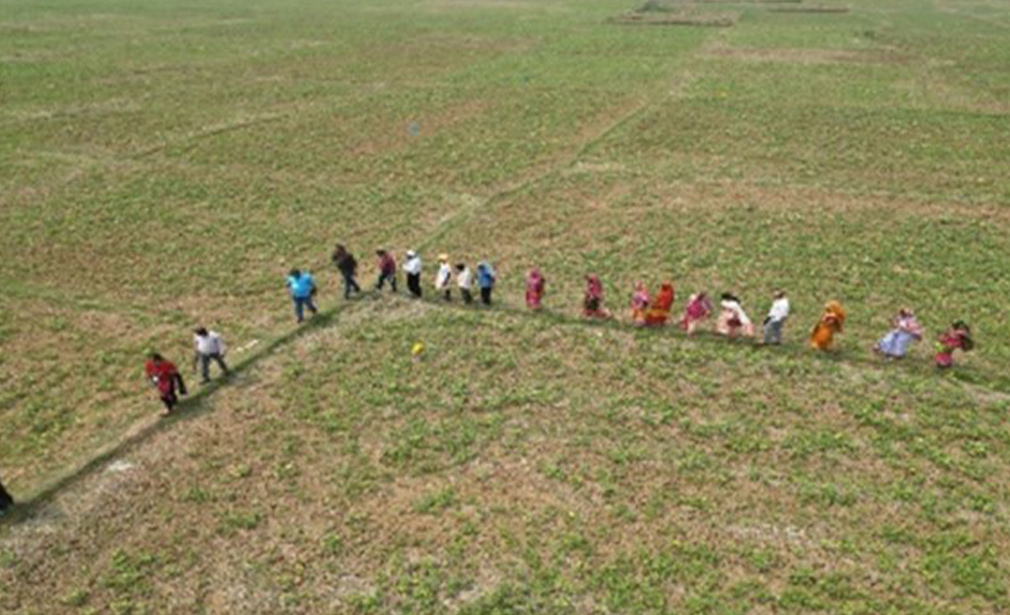In India, following the harvest of rice, most of the cultivable land remains fallow during winter. With appropriate interventions, we could enable to intensify rice-fallow areas with suitable low duty crops like pulses and oilseeds to best use the residual moisture and left over nutrient from previous crops. As we are aware, pulses play a significant role in adding nutritional value to food (protein-rich, low-fat, and high- fibre) for human and livestock, and adding fertility to soil (i.e., protein to human food, animal fodder, and nitrogen to soil), and ensures a quick second crop after rice/main kharif crop under residual moisture conditions that adds a reliable source of a good second income to the farmers. It is low water requiring and marginally drought-tolerant crop which assists in maintaining soil nutrient status and contributes to climate resilient sustainable farming.
In India, following the harvest of rice, most of the cultivable land remains fallow during winter. With appropriate interventions, we could enable to intensify rice-fallow areas with suitable low duty crops like pulses and oilseeds to best use the residual moisture and left over nutrient from previous crops. As we are aware, pulses play a significant role in adding nutritional value to food (protein-rich, low-fat, and high- fibre) for human and livestock, and adding fertility to soil (i.e., protein to human food, animal fodder, and nitrogen to soil), and ensures a quick second crop after rice/main kharif crop under residual moisture conditions that adds a reliable source of a good second income to the farmers. It is low water requiring and marginally drought-tolerant crop which assists in maintaining soil nutrient status and contributes to climate resilient sustainable farming. Hence pulse crop is an environmentally and economically important crop in the cropping system. India being largest producer and largest consumer of pulses, would always remain an alluring market to exploit. The rice fallow areas would have various stress factors like moisture depletion resulting in terminal stress, low fertility and insect/pest/stray cattle issues that would affect crops in these rice fallow areas. Through SRFM, Orissa Foundation would support farmers via community/cluster farming (big patches instead of individual patches ensures greater possibility of social fencing; individual patches prone to cattle grazing) with important inputs like seed of suitable varieties and other critical inputs to promote the habit of the farmers to take up one more crop of pulse or oilseed in these otherwise fallow areas, so that there would be at least some return for consumption by the household, and addition of biomass and fixing nitrogen to the soil.
Additionally, solar powered fencing for prevention of stray grazing, solar powered insect traps, solar powered machineries for pulses drying, processing, value addition, and community seed banks for farmer preferred varieties would be promoted.
In India, following the harvest of rice, most of the cultivable land remains fallow during winter. With appropriate interventions, we could enable to intensify rice-fallow areas with suitable low duty crops like pulses and oilseeds to best use the residual moisture and left over nutrient from previous crops. As we are aware, pulses play a significant role in adding nutritional value to food (protein-rich, low-fat, and high- fibre) for human and livestock, and adding fertility to soil (i.e., protein to human food, animal fodder, and nitrogen to soil), and ensures a quick second crop after rice/main kharif crop under residual moisture conditions that adds a reliable source of a good second income to the farmers. It is low water requiring and marginally drought-tolerant crop which assists in maintaining soil nutrient status and contributes to climate resilient sustainable farming. Hence pulse crop is an environmentally and economically important crop in the cropping system. India being largest producer and largest consumer of pulses, would always remain an alluring market to exploit. The rice fallow areas would have various stress factors like moisture depletion resulting in terminal stress, low fertility and insect/pest/stray cattle issues that would affect crops in these rice fallow areas. Through SRFM, Orissa Foundation would support farmers via community/cluster farming (big patches instead of individual patches ensures greater possibility of social fencing; individual patches prone to cattle grazing) with important inputs like seed of suitable varieties and other critical inputs to promote the habit of the farmers to take up one more crop of pulse or oilseed in these otherwise fallow areas, so that there would be at least some return for consumption by the household, and addition of biomass and fixing nitrogen to the soil.
Additionally, solar powered fencing for prevention of stray grazing, solar powered insect traps, solar powered machineries for pulses drying, processing, value addition, and community seed banks for farmer preferred varieties would be promoted.


